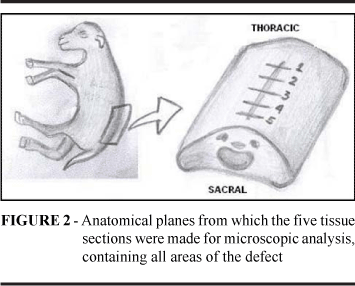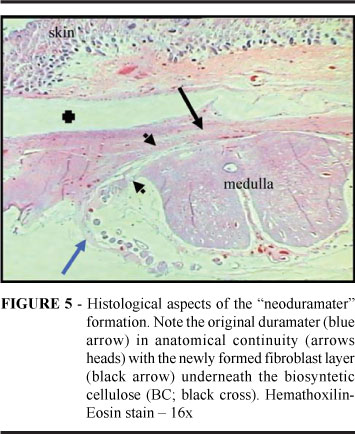PURPOSE: The aim of this study was to compare the effectiveness of two dura-mater substitutes, namely human acellular dermal matrix (HADM) and biosynthetic cellulose (BC), in repairing, in utero, surgically-induced meningomyelocele (MMC) in fetal sheep. METHODS: A neural tube defect was created at 74-77 days gestation in 36 fetal sheep. They were divided into 3 groups, the control group that did not receive pre-natal corrective surgery, and the other two groups that received corrective surgery using HADM (Group A) or BC (Group B). Both materials were used as a dura-mater substitutes between the neural tissue and the sutured skin. Correction was performed at gestation day 100 and the fetuses were maintained in utero until term. Sheep were sacrificed on gestation day 140. The fetal spine was submitted to macro and microscopic analysis. At microscopy, adherence of the material to the skin and neural tissue was analyzed. RESULTS: In the initial phase (pilot), experimentally-induced MMC was performed on 11 fetuses and 4 survived (37%). In the second phase (study), 25 fetuses received surgery and 17 survived (68%). In the study group, 6 fetuses did not undergo repair (control group), 11 cases were submitted to corrective surgery (experimental group) and one fetal loss occurred. Of the surviving cases in the experimental group, 4 constituted Group A and 6 in Group B. Macroscopically, skin and underlying tissues where easily displaced from the BC in all cases it was used; in contrast, HADM adhered to these tissues. To compare the adherence, 4 cases from Group A and 4 in Group B were studied. We observed adherence, host cell migration and vessel proliferation into the HADM all sections from Group A and this aspect was not present in any cases in Group B (p < 0.05). In Group B, we also observed that a new fibroblast layer formed around the BC thus protecting the medulla and constituting a "neoduramater". CONCLUSION: The use of BC seems to be more adequate as a dura-mater substitute to cover the damaged neural tissue than HADM. It seems promising for use in the in utero correction of MMC because to does not adhere to neural tissue of superficial and deep layers ("tethered spinal cord"). Thus, BC minimizes the mechanical and chemical intrauterine damage to the spinal medulla.
Fetus; Meningomyelocele; Spinal dysraphism; Prenatal care; Cellulose; Animal experimentation; Sheep







